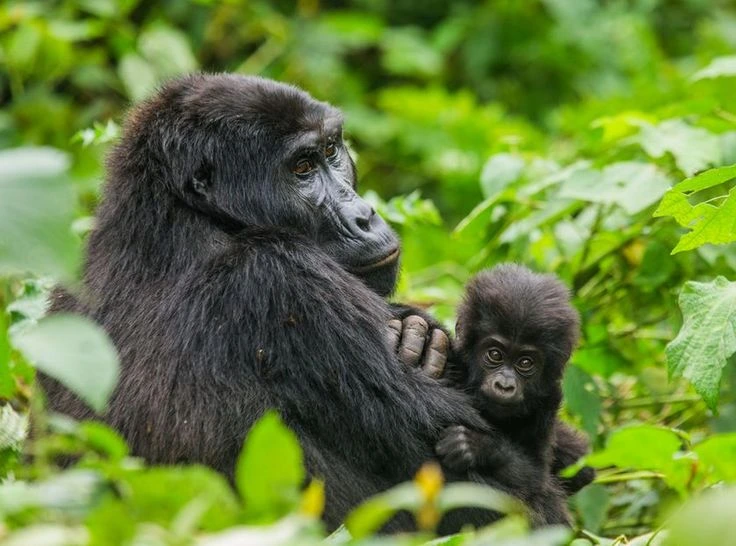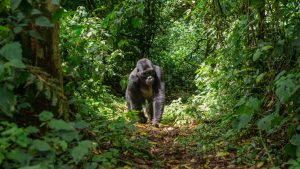Encountering a gorilla in the wild stands among the most extraordinary wildlife experiences. Gorillas communicate primarily through non-verbal signals, including body language, vocalizations, and gestures, which humans can learn to interpret but cannot replicate fluently. Understanding gorilla communication ensures safe and respectful interaction during trekking and supports conservation efforts. How Does One Communicate to a Gorilla? This post explores how gorillas communicate, how humans can respond appropriately, and why respectful communication matters.
How Do Gorillas Communicate Within Their Groups?
Gorillas rely on a sophisticated system of non-verbal communication to maintain social bonds, assert dominance, and express emotions. They convey messages primarily through body language, facial expressions, posture, and physical gestures. For example, a silverback gorilla may beat its chest to display strength and warn rivals or threats. When gorillas groom each other or sit close, they demonstrate social bonding and calmness.
Gorillas also use facial expressions extensively: a relaxed face with closed eyes signals contentment, while a tense mouth or wide-open eyes can indicate agitation or fear. Postures communicate status—dominant males often stand tall and erect, while submissive individuals may crouch or avoid eye contact. Understanding these signals helps humans interpret gorilla moods and intentions during encounters.
What Types of Vocalizations Do Gorillas Use?
Gorillas produce a range of vocalizations, each serving different social or environmental purposes. They grunt to maintain contact within the group, especially when moving through dense forests. Hoots and roars often alert the group to potential dangers or territorial intrusions. Screams and barks typically indicate distress or aggression.
Scientists have identified over 20 distinct gorilla sounds, each corresponding to specific behavioral contexts. For instance, “soft grunts” usually occur during feeding, signaling contentment, while “loud roars” serve as warnings to rivals or predators. Although humans cannot mimic these sounds effectively, listening attentively helps guides and trekkers understand gorilla behavior in real time.
How Do Gorillas Use Gestures to Communicate?
Gestures provide gorillas with visual cues to express intentions or emotions. Chest beating stands as the most iconic gesture, signaling dominance and warning others to stay away. Gorillas also shake branches or slap the ground when threatened or to display power.
Friendly gestures include arm extensions inviting play or grooming, gentle touching, and mutual grooming sessions, which reinforce social bonds and reduce tension. Gorillas sometimes use gestures to direct attention or initiate interactions with group members.
When humans witness these gestures, they should respect the gorillas’ space and avoid sudden movements or responses that could startle or provoke.
How Do Humans Communicate with Gorillas?
Humans cannot communicate with gorillas through spoken language but can communicate by respecting gorilla signals and following established behavioral protocols. During trekking, guides instruct visitors to move quietly, avoid direct eye contact (which gorillas may interpret as a threat), and refrain from sudden movements.
Maintaining calm and gentle body language helps reassure gorillas and prevents stress or defensive behavior. Visitors should keep a safe distance, usually around seven meters, and avoid touching or attempting to interact physically. By observing gorilla signals and responding calmly, humans communicate non-verbally that they pose no threat.
Why Is It Important to Understand Gorilla Communication During Trekking?
Understanding gorilla communication enhances safety for both humans and gorillas. Gorillas view unfamiliar humans as potential threats, and misinterpreted signals can lead to aggressive behavior. Trekking guides rely on knowledge of gorilla body language and vocalizations to assess group mood and decide when it is safe to approach or observe.
Respecting communication cues minimizes disturbance, protects gorilla health by reducing stress, and preserves natural behaviors. When trekkers appreciate gorilla signals, they help maintain ethical wildlife tourism standards and support ongoing conservation efforts.
Can Humans Learn to Speak or Mimic Gorilla Communication?
Humans cannot fully learn or replicate gorilla communication due to differences in vocal anatomy and cognitive processing. While researchers study gorilla gestures and vocal patterns extensively, gorillas do not understand human speech and humans cannot perfectly imitate gorilla sounds or body language.
Attempts by tourists to mimic gorilla behavior can confuse or stress the animals, potentially disrupting social dynamics. Therefore, experts advise visitors to observe silently and avoid mimicking gorilla sounds or gestures during encounters.
How Do Researchers Communicate or Interact with Gorillas?
Researchers spend years habituating gorilla groups to human presence, gradually building trust through consistent, calm, and non-threatening behavior. They communicate non-verbally, interpreting subtle gestures and vocalizations to study social structure, health, and behavior.
Researchers may use hand signals or body positioning to avoid startling gorillas. They avoid loud noises, direct eye contact, or any action that might provoke fear or aggression. Occasionally, researchers may use food to reinforce habituation, but strict ethical guidelines govern such interactions to prevent dependence or behavioral changes.
What Are the Do’s and Don’ts When Communicating with Gorillas?
Do:
- Maintain a safe distance (typically 7 meters).
- Move slowly and calmly, avoiding sudden movements.
- Follow your guide’s instructions carefully.
- Speak softly or remain silent during the trek.
- Observe gorilla body language and respect their space.
Don’t:
- Make direct eye contact with gorillas.
- Attempt to touch or feed gorillas.
- Imitate gorilla sounds or gestures.
- Use flash photography or loud noises.
- Approach gorillas if they show signs of agitation or aggression.
Following these guidelines ensures your safety and preserves the gorillas’ well-being.
How Does Understanding Gorilla Communication Support Conservation Efforts?
Respectful interaction based on understanding gorilla communication strengthens conservation efforts by reducing human-wildlife conflict and promoting ethical tourism. When visitors behave appropriately, gorillas experience less stress, which supports their health and reproductive success.
Educated tourists become conservation ambassadors, spreading awareness about gorilla behavior, habitat needs, and threats like poaching and disease. This increased awareness generates support for funding anti-poaching patrols, habitat protection, and community engagement programs, all vital to gorilla survival.
Conclusion
How Does One Communicate to a Gorilla? Communicating with gorillas requires attentiveness to their body language, vocalizations, and gestures rather than spoken language. Humans can interact safely and respectfully by observing these signals, maintaining calm behavior, and following strict guidelines. Understanding gorilla communication enhances the trekking experience, protects the animals, and promotes conservation goals.
By approaching gorillas with knowledge and respect, visitors contribute to the ongoing efforts to protect these magnificent primates for future generations. How Does One Communicate to a Gorilla?




